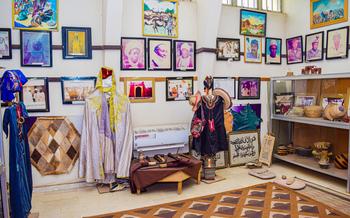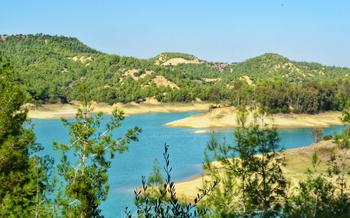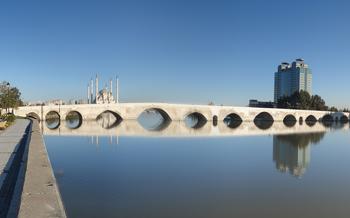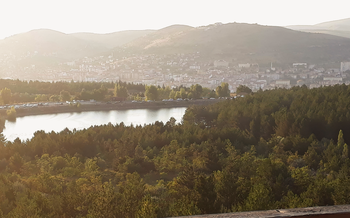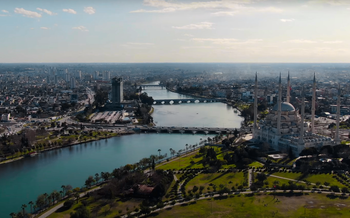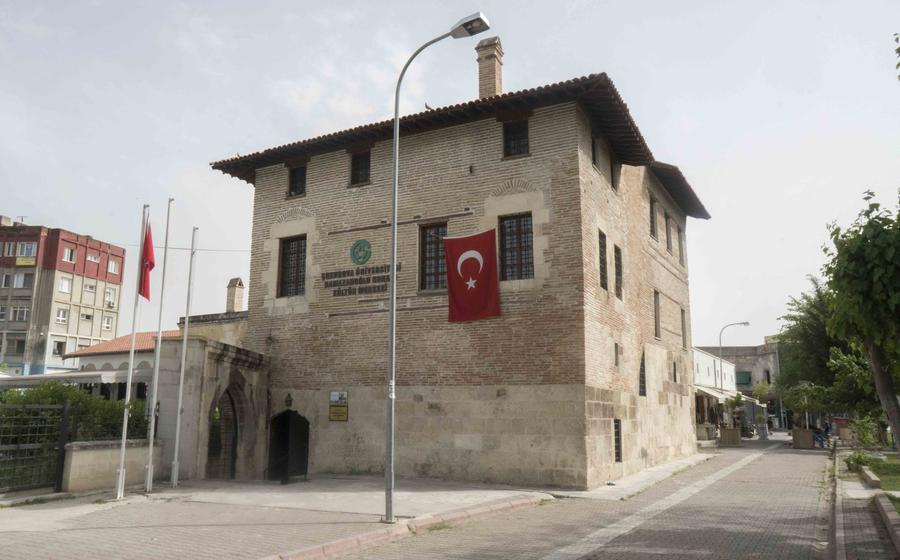
Ramazanoğlu Hall
- Ramazanoğlu Hall: Adana's Stunning Historical Jewel
- Unveiling the Hall's Rich History
- Exploring the Architectural Masterpiece
- The Hall's Cultural Legacy
- Transformation into a Museum
- Immersive Museum Experience
- Adana's Historical Context
- The Hall's Location and Accessibility
- Visiting Hours and Admission Fees
- Discover Adana's Culinary Delights
- Exploring the City's Other Treasures
- Photography and Social Media: Sharing the Beauty of Ramazanoğlu Hall
- Respecting Local Customs and Traditions
Ramazanoğlu Hall: Adana's Stunning Historical Jewel
A Journey into the Past In the heart of Adana, a city brimming with history and cultural treasures, stands the Ramazanoğlu Hall, a magnificent architectural marvel that has stood tall for centuries, silently narrating the tale of Adana's rich past. Constructed in the 15th century by the Ramazanoğlu Dynasty, this awe-inspiring hall exudes an aura of grandeur and elegance, embodying the city's historical significance and cultural heritage. As a testament to the architectural prowess of its time, the Ramazanoğlu Hall proudly showcases a harmonious blend of Anatolian and Islamic influences, making it a true masterpiece that captivates the hearts of visitors from around the world.
Unveiling the Hall's Rich History
The Ramazanoğlu Hall, a testament to the city's storied past, traces its origins back to the 15th century when the Ramazanoğlu Dynasty, a powerful Anatolian beylik, ruled over Adana and its surrounding region. The dynasty, known for its patronage of the arts and architecture, commissioned the construction of the hall as a testament to their power and prestige.
The hall's construction was overseen by Halil Bey, the third ruler of the Ramazanoğlu Dynasty, who sought to create a grand and imposing structure that would serve as the seat of his government and a venue for important ceremonies. The hall was completed in 1498, showcasing a blend of architectural styles that reflected the dynasty's eclectic cultural influences.
After the fall of the Ramazanoğlu Dynasty in the 16th century, the hall came under Ottoman rule and was used for various administrative purposes. During the Ottoman period, the hall underwent several renovations and modifications, adapting to the changing needs of the empire.
In the 20th century, the hall's historical significance was recognized, and efforts were made to restore it to its former glory. Extensive restoration work was undertaken, guided by a deep respect for the hall's architectural integrity and historical value. The meticulous restoration process aimed to preserve the hall's original features while adapting it to its new role as a museum.
Exploring the Architectural Masterpiece
Adana's Ramazanoğlu Hall stands as a testament to the city's rich architectural heritage, boasting a harmonious blend of architectural styles that reflect the region's diverse history. The hall's exterior is characterized by its imposing stone façade, adorned with intricate carvings and decorative elements that showcase the remarkable craftsmanship of the Ramazanoğlu dynasty. The main entrance, a grand arched doorway, invites visitors into a world of architectural splendor.
Inside, the hall's vast interior is a symphony of stone and light. The walls are adorned with intricate stonework, featuring geometric patterns, floral motifs, and calligraphic inscriptions that tell the story of Adana's past. The high, vaulted ceilings are supported by imposing columns, creating a sense of awe and grandeur. The hall's layout is designed to impress, with its central courtyard surrounded by iwans, or arched alcoves, each featuring unique decorative elements and providing a glimpse into the building's rich history.
The Ramazanoğlu Hall's architectural details are not merely decorative; they hold symbolic and functional significance. The positioning of the windows allows for optimal airflow and natural lighting, creating a comfortable environment for those gathered within. The decorative motifs and inscriptions not only enhance the hall's aesthetic appeal but also convey messages and commemorate important events in Adana's history.
Exploring the Ramazanoğlu Hall is a journey through time, allowing visitors to appreciate the architectural brilliance of the past and marvel at the enduring legacy of the Ramazanoğlu dynasty. Each element of the hall's design contributes to its overall grandeur, making it a masterpiece of Islamic architecture that continues to inspire and awe visitors to this day.
The Hall's Cultural Legacy
The Ramazanoğlu Hall has served as a cultural hub for Adana throughout history. In the past, it was the central location for local governance, where important decisions were made and justice was administered. It also played a crucial role in official ceremonies and celebrations, hosting dignitaries and guests of honor.
Over the centuries, the hall has become a symbol of Adana's rich heritage and cultural identity. It represents the city's enduring spirit and resilience, having witnessed countless events that have shaped its history. The hall has been instrumental in preserving local traditions and customs, ensuring their continuity from one generation to the next.
Today, the hall continues to serve as a vital cultural center, hosting various exhibitions, events, and performances that celebrate Adana's unique identity. It is a place where locals and visitors alike can come together to learn about the city's past, appreciate its present, and envision its future.
Transformation into a Museum
In the latter half of the 20th century, the Ramazanoğlu Hall underwent a significant transformation, evolving from a historical landmark into a vibrant museum. The decision to convert the hall into a cultural institution was driven by a desire to preserve its architectural and historical significance while making it accessible to the public.
The process of restoration and renovation was meticulously undertaken, respecting the hall's original features while adapting it to its new role. Challenges arose during this transformation, including the need to balance historical accuracy with modern museological standards. The goal was to create a space that paid homage to the past while providing a modern and engaging museum experience.
The establishment of the Ramazanoğlu Hall Museum marked a pivotal moment in Adana's cultural landscape. It not only preserved a cherished historical site but also created a platform for showcasing the city's rich heritage and traditions to both local and international visitors.
Immersive Museum Experience
The Ramazanoğlu Hall has been transformed into a captivating museum that offers an immersive experience to visitors. Inside, you'll find a treasure trove of exhibits that showcase Adana's rich history, from ancient times to the present day. Interactive displays and multimedia presentations bring the past to life, allowing you to engage with the city's heritage in a dynamic and engaging way.
Educational programs and workshops are regularly organized at the museum, providing opportunities for visitors of all ages to learn more about Adana's culture and traditions. Guided tours are also available, led by knowledgeable guides who can share insights and stories that you might not find elsewhere. Cultural events, such as concerts, exhibitions, and performances, are also held at the museum, adding to its vibrant atmosphere.
Adana's Historical Context
Ancient Civilizations and Settlements
The lands of Adana have been inhabited since ancient times, with evidence of settlements dating back to the Neolithic era. The city's strategic location, nestled between the Taurus Mountains and the Mediterranean Sea, made it a natural crossroads for trade and cultural exchange. In the Bronze Age, Adana flourished as a major center of the Hittite Empire, leaving behind impressive ruins and artifacts that testify to its ancient glory.
Role in the Silk Road Trade
During the Silk Road era, Adana served as a vital hub for trade between the East and the West. Caravans laden with precious goods, such as silk, spices, and gold, passed through the city, contributing to its economic prosperity and cultural diversity. The city's strategic position allowed it to flourish as a center of commerce and exchange, connecting different cultures and civilizations along the ancient trade routes.
Ottoman Rule and Modernization
In the 16th century, Adana fell under Ottoman rule and became an important administrative center within the empire. The Ottomans left a lasting impact on the city's architecture and culture, constructing mosques, caravanserais, and other landmarks that are still standing today. During the 19th century, Adana underwent a period of modernization, with the introduction of new technologies and infrastructure. The city's economy and population grew rapidly, transforming it into a bustling center of trade and industry.
Modern-day Adana
Today, Adana is a thriving metropolis, blending its rich history with a modern and cosmopolitan atmosphere. The city is home to a diverse population, reflecting its centuries-long role as a melting pot of cultures. Adana's vibrant culinary scene, bustling markets, and energetic nightlife make it a popular destination for both domestic and international visitors, eager to explore its unique charm and hospitality.
The Hall's Location and Accessibility
Adana's Historical Heart
The Ramazanoğlu Hall stands proudly in the heart of Adana, surrounded by a rich tapestry of historical sites and cultural landmarks. It is nestled within the city's Old Town, a vibrant and charming neighborhood that exudes an Old World charm. The hall's strategic location makes it easily accessible to visitors, inviting them to delve into the city's captivating past.
Proximity to Historical Treasures
The Ramazanoğlu Hall is in close proximity to a plethora of other historical sites, allowing visitors to embark on a journey through time. The magnificent Adana Ulu Mosque, with its towering minarets and intricate architecture, is just a short walk away. Visitors can also explore the remnants of the ancient city of Anavarza, located on the outskirts of Adana, and marvel at its well-preserved Roman ruins.
Convenient Transportation Options
Adana is well-connected by public transportation, making it easy for visitors to reach the Ramazanoğlu Hall. Several bus routes stop nearby, and the city's modern tramway system provides convenient access to the Old Town. For those who prefer to drive, ample parking is available in the vicinity of the hall, ensuring a hassle-free visit.
Visiting Hours and Admission Fees
The Ramazanoğlu Hall Museum welcomes visitors with open arms, offering a range of visiting hours to accommodate various schedules. Its doors are typically open from 8:00 AM to 5:00 PM, seven days a week, providing ample opportunities to explore the wonders within.
Admission fees are set to ensure that everyone can experience the museum's treasures. Regular tickets are priced affordably, allowing for a budget-friendly visit. Children, students, and senior citizens are eligible for discounted rates, making it accessible to all.
For larger groups, special rates are available, offering a cost-effective way to delve into the museum's history. Additionally, the museum offers free admission days or periods throughout the year, providing an excellent chance to visit without any financial burden.
Discover Adana's Culinary Delights
Adana holds a prominent place in Turkish cuisine and is renowned for its tantalizing flavors and unique culinary traditions. It is a foodie's paradise, boasting an array of must-try dishes that will delight your taste buds and leave you craving for more.
Adana Kebab: A Culinary Icon
Adana kebab, a succulent skewer of minced lamb grilled to perfection, is the city's signature dish and a must-try for any visitor. The meat is seasoned with a blend of spices and herbs, giving it a distinctive and irresistible flavor. Savor the smoky aroma and tender texture as you bite into this culinary masterpiece, accompanied by grilled vegetables and tangy şalgam juice.
Şalgam: A Refreshing Accompaniment
Şalgam, a fermented turnip juice, is an integral part of the Adana kebab experience. This unique beverage, with its vibrant purple hue and slightly sour taste, is the perfect complement to the rich flavors of the kebab. Its refreshing and tangy notes balance the intensity of the grilled meat, creating a harmonious culinary symphony.
Exploring Local Specialties
Beyond kebab and şalgam, Adana offers a diverse range of local specialties that showcase the city's culinary prowess. Indulge in "ciğer dürüm," a wrap filled with grilled liver and onions, or savor the crispy "sıkma," a fried dough pastry similar to a donut. For a sweet treat, try "künefe," a shredded filo pastry filled with cheese and drizzled with sweet syrup.
Finding Authentic Culinary Gems
To experience the true essence of Adana's cuisine, venture into the city's vibrant markets and bazaars, where you can interact with local vendors and discover hidden culinary treasures. Ask for recommendations, sample different dishes, and immerse yourself in the lively atmosphere as you explore the city's culinary delights.
Exploring the City's Other Treasures
Beyond the Ramazanoğlu Hall, Adana offers a wealth of historical, natural, and cultural attractions waiting to be discovered. Delve into the city's rich past at historical landmarks like the Adana Ulu Mosque, with its stunning architecture and centuries-old history. Explore the unique regional culture at museums such as the Adana Ethnography Museum, showcasing traditional costumes, artifacts, and local crafts.
Immerse yourself in the beauty of nature at scenic spots like the Seyhan River, where you can enjoy a leisurely boat ride or stroll along the picturesque riverbanks. Escape the city's hustle and bustle at the Adana Botanical Park, a tranquil oasis filled with vibrant flora and fauna.
For a unique experience, venture beyond the city limits to explore nearby destinations such as the ancient city of Anavarza, with its impressive ruins and well-preserved mosaics. Immerse yourself in the natural wonders of the Karacaören Nature Park, home to diverse wildlife and breathtaking landscapes.
Whether you're a history buff, nature lover, or cultural enthusiast, Adana has something to offer. Embrace the opportunity to discover its hidden gems and create lasting memories in this vibrant city.
Photography and Social Media: Sharing the Beauty of Ramazanoğlu Hall
The Ramazanoğlu Hall's stunning architecture, intricate carvings, and rich history make it a photographer's paradise. Capture the grandeur of the hall's exterior and the intricate details of its interior through your lens. Share your photographs on social media platforms like Instagram, Facebook, and Twitter using hashtags such as #RamazanoğluHall, #Adana, and #Turkey. Inspire your followers to add this hidden gem to their travel bucket list. Tag the official tourism pages of Adana and Turkey to increase your reach and connect with a broader audience. By sharing your experiences, you become an ambassador for Adana's cultural heritage, encouraging others to explore this captivating city.
Respecting Local Customs and Traditions
When visiting the Ramazanoğlu Hall and exploring Adana, it's crucial to be mindful of local customs and traditions to ensure a respectful and enriching experience. Dressing appropriately is essential, avoiding revealing or overly casual attire. Adana's culture is deeply rooted in hospitality, and locals appreciate visitors who make an effort to understand and respect their way of life.
Striking up conversations with locals in a friendly and respectful manner can provide valuable insights into the city's history and traditions. However, it's important to be mindful of cultural sensitivities and avoid discussing controversial or sensitive topics. Additionally, learning a few Turkish phrases like "Merhaba" (hello) and "Teşekkür ederim" (thank you) can go a long way in showing respect and appreciation.
Remember, the people of Adana are proud of their heritage and culture, and their hospitality is renowned. By being respectful and embracing the local customs, you'll not only enhance your own experience but also foster a positive connection with the community.
